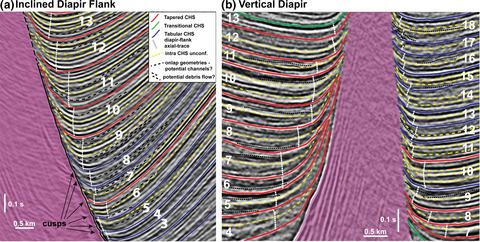当前位置:
X-MOL 学术
›
Basin Res.
›
论文详情
Our official English website, www.x-mol.net, welcomes your feedback! (Note: you will need to create a separate account there.)
Four‐dimensional Variability of Composite Halokinetic Sequences
Basin Research ( IF 3.2 ) Pub Date : 2020-01-28 , DOI: 10.1111/bre.12428 Leonardo M. Pichel 1 , Christopher A.‐L. Jackson 1
Basin Research ( IF 3.2 ) Pub Date : 2020-01-28 , DOI: 10.1111/bre.12428 Leonardo M. Pichel 1 , Christopher A.‐L. Jackson 1
Affiliation

|
[Abstract The architecture of salt diapir‐flank strata (i.e. halokinetic sequences) is controlled by the interplay between volumetric diapiric flux and sediment accumulation. Halokinetic sequences consist of unconformity‐bounded packages of thinned and folded strata formed by drape folding around passive diapirs. They are described by two end‐members: (a) hooks, which are characterized by narrow zones of folding ( 70°); and (b) wedges, typified by broad zones of folding (300–1000 m) and low taper angles (<30°). Hooks and wedges stack to form tabular and tapered composite halokinetic sequences (CHS) respectively. CHSs were most thoroughly described from outcrop‐based studies that, although able to capture their high‐resolution facies variations, are limited in describing their 4D variability. This study integrates 3D seismic data from the Precaspian Basin and restorations to examine variations in CHS architecture through time and space along diapirs with variable plan‐form and cross‐sectional geometries. The diapirs consist of curvilinear walls that vary from upright to inclined and locally display well‐developed salt shoulders and/or laterally transition into rollers. CHS are highly variable in both time and space, even along a single diapir or minibasin. A single CHS can transition along a salt wall from tabular to tapered geometries. They can be downturned and exhibit rollover‐synclinal geometries with thickening towards the diapir above salt shoulders. Inclined walls present a greater proportion of tapered CHSs implying an overall greater ratio between sediment accumulation and salt‐rise relatively to vertical walls. In terms of vertical stacking, CHS can present a typical zonation with lower tapered, intermediate tabular and upper tapered CHSs, but also unique patterns where the lower sequences are tabular and transition upward to tapered CHS. The study demonstrates that CHSs are more variable than previously documented, indicating a complex interplay between volumetric salt rise, diapir‐flank geometry, sediment accumulation and roof dimensions., Representative sections illustrating the CHS variability and near‐diapir stratal architecture across two distinct diapir‐flank geometries: (a) inclined diapir flank and (b) vertical diapir. ]
中文翻译:

复合盐动力序列的四维变异性
[摘要] 盐底辟-侧翼地层的结构(即盐动力序列)受底辟容积通量和沉积物堆积之间的相互作用控制。晕动层序包括由围绕被动底辟形成的褶皱褶皱形成的变薄和折叠地层的不整合边界包裹。它们由两个端部成员描述:(a) 钩子,其特点是折叠区窄 (70°);(b) 楔形,以宽阔的折叠区 (300–1000 m) 和低锥角 (<30°) 为代表。钩子和楔子堆叠起来分别形成表格和锥形复合盐动力序列 (CHS)。CHSs 在基于露头的研究中得到了最彻底的描述,虽然能够捕捉到它们的高分辨率相变化,但在描述它们的 4D 变化方面是有限的。该研究整合了来自前里海盆地和修复体的 3D 地震数据,以检查具有可变平面形状和横截面几何形状的底辟随时间和空间的 CHS 结构变化。底辟由曲线壁组成,从直立到倾斜不等,局部显示发育良好的盐肩和/或横向过渡到辊。CHS 在时间和空间上都是高度可变的,即使沿着单个底辟或小盆地也是如此。单个 CHS 可以沿盐壁从扁平几何形状过渡到锥形几何形状。它们可以向下倾斜并表现出翻转向斜几何形状,并在盐肩上方朝底辟增厚。倾斜的墙壁呈现出更大比例的锥形 CHS,这意味着相对于垂直墙壁,沉积物积累和盐上升之间的总体比率更大。在垂直堆叠方面,CHS 可以呈现出具有下锥形、中间板状和上锥形 CHS 的典型分区,但也有独特的模式,其中下部序列为板状并向上过渡到锥形 CHS。该研究表明,CHS 的变化比以前记录的要多,这表明盐体积上升、底辟侧翼几何形状、沉积物堆积和顶板尺寸之间存在复杂的相互作用。代表部分说明了两个不同底辟的 CHS 变异性和近底辟地层结构。侧翼几何形状:(a) 倾斜底辟侧翼和 (b) 垂直底辟。] 该研究表明,CHS 的变化比以前记录的要多,这表明盐体积上升、底辟侧翼几何形状、沉积物堆积和顶板尺寸之间存在复杂的相互作用。代表部分说明了两个不同底辟的 CHS 变异性和近底辟地层结构。侧翼几何形状:(a) 倾斜底辟侧翼和 (b) 垂直底辟。] 该研究表明,CHS 的变化比以前记录的要多,这表明盐体积上升、底辟侧翼几何形状、沉积物堆积和顶板尺寸之间存在复杂的相互作用。代表部分说明了两个不同底辟的 CHS 变异性和近底辟地层结构。侧翼几何形状:(a) 倾斜底辟侧翼和 (b) 垂直底辟。]
更新日期:2020-01-28
中文翻译:

复合盐动力序列的四维变异性
[摘要] 盐底辟-侧翼地层的结构(即盐动力序列)受底辟容积通量和沉积物堆积之间的相互作用控制。晕动层序包括由围绕被动底辟形成的褶皱褶皱形成的变薄和折叠地层的不整合边界包裹。它们由两个端部成员描述:(a) 钩子,其特点是折叠区窄 (70°);(b) 楔形,以宽阔的折叠区 (300–1000 m) 和低锥角 (<30°) 为代表。钩子和楔子堆叠起来分别形成表格和锥形复合盐动力序列 (CHS)。CHSs 在基于露头的研究中得到了最彻底的描述,虽然能够捕捉到它们的高分辨率相变化,但在描述它们的 4D 变化方面是有限的。该研究整合了来自前里海盆地和修复体的 3D 地震数据,以检查具有可变平面形状和横截面几何形状的底辟随时间和空间的 CHS 结构变化。底辟由曲线壁组成,从直立到倾斜不等,局部显示发育良好的盐肩和/或横向过渡到辊。CHS 在时间和空间上都是高度可变的,即使沿着单个底辟或小盆地也是如此。单个 CHS 可以沿盐壁从扁平几何形状过渡到锥形几何形状。它们可以向下倾斜并表现出翻转向斜几何形状,并在盐肩上方朝底辟增厚。倾斜的墙壁呈现出更大比例的锥形 CHS,这意味着相对于垂直墙壁,沉积物积累和盐上升之间的总体比率更大。在垂直堆叠方面,CHS 可以呈现出具有下锥形、中间板状和上锥形 CHS 的典型分区,但也有独特的模式,其中下部序列为板状并向上过渡到锥形 CHS。该研究表明,CHS 的变化比以前记录的要多,这表明盐体积上升、底辟侧翼几何形状、沉积物堆积和顶板尺寸之间存在复杂的相互作用。代表部分说明了两个不同底辟的 CHS 变异性和近底辟地层结构。侧翼几何形状:(a) 倾斜底辟侧翼和 (b) 垂直底辟。] 该研究表明,CHS 的变化比以前记录的要多,这表明盐体积上升、底辟侧翼几何形状、沉积物堆积和顶板尺寸之间存在复杂的相互作用。代表部分说明了两个不同底辟的 CHS 变异性和近底辟地层结构。侧翼几何形状:(a) 倾斜底辟侧翼和 (b) 垂直底辟。] 该研究表明,CHS 的变化比以前记录的要多,这表明盐体积上升、底辟侧翼几何形状、沉积物堆积和顶板尺寸之间存在复杂的相互作用。代表部分说明了两个不同底辟的 CHS 变异性和近底辟地层结构。侧翼几何形状:(a) 倾斜底辟侧翼和 (b) 垂直底辟。]



























 京公网安备 11010802027423号
京公网安备 11010802027423号